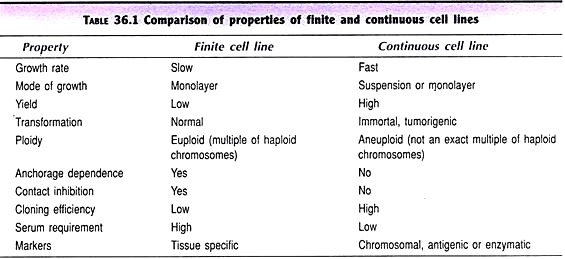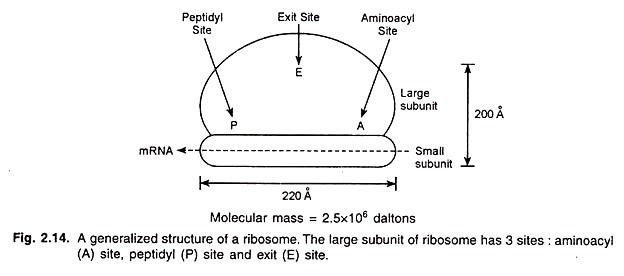Read this article to learn about the types, nomenclature, selection and maintenance of cell lines.
The development and various other aspects of primary culture are described above. The term cell line refers to the propagation of culture after the first subculture.
In other words, once the primary culture is sub-cultured, it becomes a cell line. A given cell line contains several cell lineages of either similar or distinct phenotypes.
It is possible to select a particular cell lineage by cloning or physical cell separation or some other selection method. Such a cell line derived by selection or cloning is referred to as cell strain. Cell strains do not have infinite life, as they die after some divisions.
Contents
Types of Cell Lines:
Finite Cell Lines :
The cells in culture divide only a limited number of times, before their growth rate declines and they eventually die. The cell lines with limited culture life spans are referred to as finite cell lines. The cells normally divide 20 to 100 times (i.e. is 20-100 population doublings) before extinction. The actual number of doublings depends on the species, cell lineage differences, culture conditions etc. The human cells generally divide 50-100 times, while murine cells divide 30-50 times before dying.
Continuous Cell Lines :
A few cells in culture may acquire a different morphology and get altered. Such cells are capable of growing faster resulting in an independent culture. The progeny derived from these altered cells has unlimited life (unlike the cell strains from which they originated). They are designated as continuous cell lines.
The continuous cell lines are transformed, immortal and tumorigenic. The transformed cells for continuous cell lines may be obtained from normal primary cell cultures (or cells strains) by treating them with chemical carcinogens or by infecting with oncogenic viruses. In the Table. 36.1, the different properties of finite cell lines and continuous cell lines are compared.
The most commonly used terms while dealing with cell lines are explained below.
Split ratio:
The divisor of the dilution ratio of a cell culture at subculture. For instance, when each subculture divided the culture to half, the split ratio is 1: 2.
Passage number:
It is the number of times that the culture has been sub-cultured.
Generation number:
It refers to the number of doublings that a cell population has undergone. It must be noted that the passage number and generation number are not the same, and they are totally different.
Nomenclature of Cell Lines:
It is a common practice to give codes or designations to cell lines for their identification. For instance, the code NHB 2-1 represents the cell line from normal human brain, followed by cell strain (or cell line number) 2 and clone number 1. The usual practice in a culture laboratory is to maintain a log book or computer database file for each of the cell lines.
While naming the cell lines, it is absolutely necessary to ensure that each cell line designation is unique so that there occurs no confusion when reports are given in literature. Further, at the time of publication, the-cell line should be prefixed with a code designating the laboratory from which it was obtained e.g. NCI for National Cancer Institute, Wl for Wistar Institute.
Commonly used cell lines:
There are thousands of cell lines developed from different laboratories world over. A selected list of some commonly used cell lines along with their origin, morphology and other characters are given in Table. 36.2.
Selection of Cell Lines:
Several factors need to be considered while selecting a cell line.
Some of them are briefly described:
1. Species:
In general, non-human cell lines have less risk of biohazards, hence preferred. However, species differences need to be taken into account while extrapolating the data to humans.
2. Finite or continuous cell lines:
Cultures with continuous cell lines are preferred as they grow faster, easy to clone and maintain, and produce higher yield. But it is doubtful whether the continuous cell lines express the right and appropriate functions of the cells. Therefore, some workers suggest the use of finite cell lines, although it is difficult.
3. Normal or transformed cells:
The transformed cells are preferred as they are immortalized and grow rapidly.
4. Availability:
The ready availability of cell lines is also important. Sometimes, it may be necessary to develop a particular cell line in a laboratory.
5. Growth characteristics:
The following growth parameters need to be considered:
i. Population doubling time
ii. Ability to grow in suspension
iii. Saturation density (yield per flask)
iv. Cloning efficiency.
6. Stability:
The stability of cell line with particular reference to cloning, generation of adequate stock and storage are important.
7. Phenotypic expression:
It is important that the cell lines possess cells with the right phenotypic expression.
Maintenance of Cell Cultures:
For the routine and good maintenance of cell lines in culture (primary culture or subculture) the examination of cell morphology and the periodic change of medium are very important.
Cell Morphology:
The cells in the culture must be examined regularly to check the health status of the cells, the absence of contamination, and any other serious complications (toxins in medium, inadequate nutrients etc.).
Replacement of Medium:
Periodic change of the medium is required for the maintenance of cell lines in culture, whether the cells are proliferating or non-proliferating. For the proliferating cells, the medium need to be changed more frequently when compared to non-proliferating cells. The time interval between medium changes depends on the rate of cell growth and metabolism.
For instance, for rapidly growing transformed cells (e.g. HeLa), the medium needs to be changed twice a week, while for slowly growing non-transformed cells (e.g. IMR-90) the medium may be changed once a week. Further, for rapidly proliferating cells, the sub-culturing has to be done more frequently than for the slowly growing cells.
The following factors need to be considered for the replacement of the medium:
1. Cell concentration:
The cultures with high cell concentration utilize the nutrients in the medium faster than those with low concentration; hence the medium is required to be changed more frequently for the former.
2. A decrease in pH:
A fall in the pH of the medium is an indication for change of medium. Most of the cells can grow optimally at pH 7.0, and they almost stop growing when the pH falls to 6.5. A further drop in pH (between 6.5 and 6.0), the cells may lose their viability.
The rate of fall in pH is generally estimated for each cell line with a chosen medium. If the fall is less than 0.1 pH units per day, there is no harm even if the medium is not immediately changed. But when the fall is 0.4 pH units per day, medium should be changed immediately.
3. Cell type:
Embryonic cells, transformed cells and continuous cell lines grow rapidly and require more frequent sub-culturing and change of medium. This is in contrast to normal cells, which grow slowly.
4. Morphological changes:
Frequent examination of cell morphology is very important in culture techniques. Any deterioration in cell morphology may lead to an irreversible damage to cells. Change of the medium has to be done to completely avoid the risk of cell damage.

